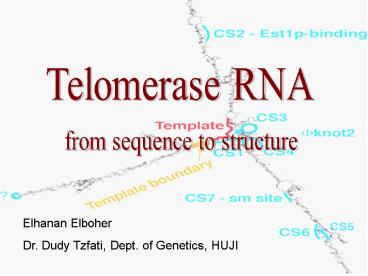Telomerase RNA - PowerPoint PPT Presentation
1 / 25
Title:
Telomerase RNA
Description:
Telomerase RNA (TER): Sequential and Structural Characteristics ... Tools and Specific Problems of Yeast TER ... The Problems in the case of yeast TER: ... – PowerPoint PPT presentation
Number of Views:1413
Avg rating:5.0/5.0
Title: Telomerase RNA
1
Telomerase RNA
from sequence to structure
Elhanan Elboher Dr. Dudy Tzfati, Dept. of
Genetics, HUJI
2
The Telomerase RNP complex adds short DNA repeats
to the end of the chromosome
3
The Telomerase RNP complex adds short DNA repeats
to the end of the chromosome
4
The Telomerase RNP complex adds short DNA repeats
to the end of the chromosome
5
The Telomerase RNP complex adds short DNA repeats
to the end of the chromosome
6
The Telomerase RNP complex adds short DNA repeats
to the end of the chromosome
7
Telomerase RNA (TER) - Functions
- Contains the template for the telomeric repeats
- Regulates the length of the transcribed sequence
(by a template boundary element) - Scaffold that the elements of the complex (TERT
and other factors) are bound to - Regulates the activity of the whole complex, by a
switch between different states
8
Telomerase RNA (TER) Sequential and
Structural Characteristics
- Divergent length (Vertebrates 450 nt, Ciliates
150 nt, Yeast 1000 nt) - Low conservation of the sequence, even among
closed species - Higher conservation of short subsequences which
are involved in formation of functional
structural elements - General structure in Yeast species three long
arms and a central catalytic core, contains an
essential pseudoknot element
9
Saccharomyces
Secondary Structure Models of Two
Yeast TER Groups
Kluyveromyces
10
Conserved Sequences in the Kluyveromyces Group
11
My Project - Objectives
- Focus on a third yeasts group, Candida
- Finding the exact start end points of the
folded sequence - Structural elements which are known as essential
from other species (template boundary, protein
binding domains, ?-knot etc.) - Novel structural elements
- Contribute to the general model of the secondary
and tertiary structure of the yeast telomerase RNA
12
My Project - Objectives
- Focus on a third yeasts group, Candida
- Finding the exact start end points of the
folded sequence - Structural elements which are known as essential
from other species (template boundary, protein
binding domains, ?-knot etc.) - Novel structural elements
- Contribute to the general model of the secondary
and tertiary structure of the yeast telomerase RNA
13
Delimitation of the Gene
- Gussinova and Tomaska (2007) found the locus of
TLC1 in six species - This locus contains an expected template
sequence which fits the telomeric repeat - The exact limits of the folded sequences were
determined by multiple alignment against the
known sequence of C. albicans - The Sm protein binding site was found during the
alignment
14
Secondary Structure Prediction Classical Tools
and Specific Problems of Yeast TER
- Two basic programs
- Mfold / RNAfold folds a single sequence to the
secondary structure with the minimal free energy
(M. Tzuker) - RNAalifold folds a group of aligned sequences.
Takes into consideration energy, conservation and
co-variation (Vienna RNA Package) - These tools are based on a dynamic programming
algorithm. - The Problems in the case of yeast TER
- Very long sequences (1500-1800 nt)
many different
reasonable optional foldings - Ignoring previous biological data (conserved
sub-sequences and functional structural elements) - These tools cannot predict pseudoknots
15
Most of the RNA structural elements obey the
brackets rule
( ( D ) ( A ) ( T ) )
ACGUGCCACGAUUCAACGUGGCACAG ((((((((
))))))))
16
Pseudoknot is a RNA structural element which
breaks the brackets rule
3
j
j
i
i
5
These two stems cross each other. Formally, i j Dynamic programming algorithms cannot predict
such structures!
17
CS3 and CS4 form a special structure of a
pseudoknot which contains a triple helix
Lets convert it to formal constraints
CS3
CS4 (
( ( ( ( ( ( ( ( ( )
) ) ) ) ) ) ) ) )
stem 1 UUU UUU stem 1
AAA
( ( (
( ( (
18
Searching for the Pseudoknot
- Generate a base pairs matrix for each sequence
- Represent all optional stable stems (parameters
length, H. bonds, bulges) - Find all optional structures which hold the
pseudoknots constraints - Look for conservation of the pattern at closed
locations - Will the program find the PKs of the known
species?
19
Pseudoknot - Results
- The program found the CS3 of Kluyveromyces and
Saccharomyces as the most likely option. - There was found a homologous sequence for the
Candida species, in an appropriate place within
the whole sequence. - From the relevant candidates for CS4, there is
one with high similarity to S.cerevisiae, both in
sequence and structure.
20
Evolution of the CS3 Loop
The stem of CS3 is not conserved at all among the
different groups.
21
Models of the Pseudoknot Saccharomyces,
Kluyveromyces, Candida
K. lactis
22
Est1p Binding Site
obtained by a manipulation of a motif finding
program (MEME), Mfold, RNAalifold, and previous
knowledge
23
An Essential Three-Way Junction
- Approaches
- Pattern Location
- Parsing tree of a probabilistic CFG
24
Future Directions
- Find all known essential elements (TWJ, template
boundary etc.) - Demonstrate a full secondary structure model
- Identify additional tertiary interactions
- Generalize the results to a model that will
enable genomic searching
25
Acknowledgments
- Dudy Tzfati
- Lubo Tomaska, Josef Nosek
- Nickolay Ulyanov
- Yogev Brown
- Hanah Margalit
- Tommy Kaplan































